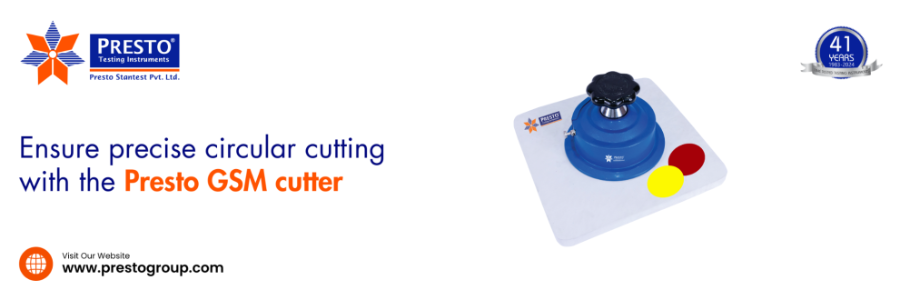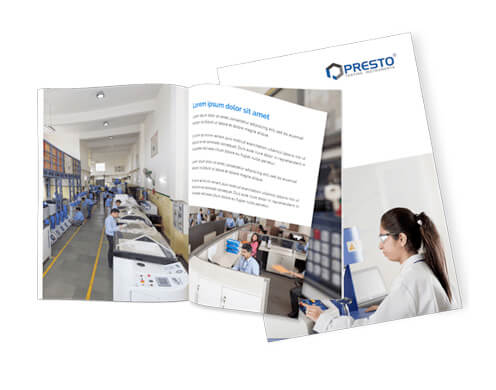Ensure precise circular cutting with the Presto GSM cutter

Gaurav Malhotra
22-07-2024
Unveiling the GSM Cutter: Revolutionizing Textile Quality Assurance
In the world of fabric manufacturing, making sure of consistency and quality throughout cloth samples is paramount. This is wherein the GSM (Grams according to Square Meter) cutter emerges as a critical tool. From figuring out cloth weight to assessing cloth composition, the GSM cutter performs a pivotal position in retaining requirements and optimizing manufacturing processes. Let us delve into what a GSM cutter is, its applications, and its importance inside the industry, and cope with 3 often-asked questions on this vital instrument.
What is a GSM Tester?
A GSM Tester, additionally referred to as a material pattern cutter, is a precision tool designed to reduce specific round or rectangular samples of cloth with a special area. These samples are then weighed to calculate the GSM, which suggests the burden of the cloth according to unit area (grams according to rectangular meter). This dimension is essential in figuring out cloth density, thickness, and general quality.
GSM cutters are to be had in numerous sizes and configurations to house distinctive cloth sorts and pattern sizes. They commonly characteristic sharp round blades or dies that ensure smooth cuts without fraying or distorting the cloth edges. Some superior fashions may also encompass functions that include adjustable pattern sizes, ergonomic layouts for ease of use, and included scales for direct GSM calculation.
Uses and Applications of GSM Cutters
1. Quality Control and Assurance: In fabric manufacturing, consistency in cloth weight is crucial to retaining the product quality. GSM cutters allow producers to take specific samples from bulk cloth rolls or completed merchandise for proper assessment. By making sure that cloth meets special GSM necessities, producers can uphold requirements and meet purchaser expectations.
2. Research and Development: Textile researchers use GSM cutters to research and evaluate distinctive cloth samples. By measuring GSM, researchers can verify elements which include cloth density, porosity, and overall performance characteristics. This information is worthwhile in making new fabrics, enhancing present merchandise, and innovating in the fabric industry.
3. Compliance and Standards: Many industries, inclusive of apparel, domestic textiles, and commercial fabrics, have stringent regulatory necessities concerning cloth weight and quality. GSM of fabric helps producers comply with those requirements via way of imparting correct and repeatable measurements.
Importance of GSM Cutters
1. Precision and Accuracy: GSM measurement makes sure of specific and regular pattern reduction, which is vital for correct GSM calculations. This reliability facilitates producers to keep uniformity in cloth weight throughout manufacturing batches, decreasing versions and making sure of product consistency.
2. Efficiency and Productivity: By automating the pattern-reducing process, GSM cutters streamline great management processes in fabric generators and laboratories. This performance now efficiently saves time and additionally improves general productiveness via means of allowing quicker evaluation and decision-making.
3. Cost Optimization: Proper GSM dimension facilitates optimizing cloth utilization and reducing waste. By appropriately figuring out cloth weight, producers can keep away from over-specification of substances and decrease useless prices related to extra cloth consumption.
Three FAQs About GSM Cutters
Q1. How do GSM cutters ensure accuracy in fabric sampling?
A1. GSM cutters use precise cutting mechanisms (such as circular blades or dies) calibrated to cut samples of exact dimensions. This ensures that each fabric sample has a consistent area, facilitating accurate GSM calculation.
Q2. What factors should be considered while selecting a GSM cutter for optimizing the quality of the product?
A. When selecting a GSM cutting machine, one should consider the type of fabric being processed (woven, knitted, etc.), the required sample size, the cutting mechanism (manual or automatic), and integration under a scale. It is also important to select an instrument that meets industry standards and regulatory requirements for your specific use.
Q3. How can GSM measurements impact product performance in textiles?
A. GSM measurements provide insights into fabric characteristics such as thickness, density, and durability. Fabrics with higher GSM may offer better insulation or durability, making them suitable for applications requiring robust materials. Conversely, lower GSM fabrics may be preferred for lightweight and breathable textiles.
Advancements in GSM Cutter Technology
Advances in GSM cutting technology have improved its performance and use in the textile industry. The latest GSM routers feature digital interfaces for precise control and measurement, automatic cutoff mechanisms for increased efficiency, and integrated systems for data analysis and reporting. These advances not only improve accuracy but also simplify the workflow of concerned manufacturers and researchers.
Reach out to us by phone at +91 9210903903 or by directly dropping us an e-mail at info@prestogroup.com.
Recent News
- Paper & Packaging Testing Instruments
- Paint, Plating & Coating Testing Instruments
- Plastic & Polymer Testing Instruments
- Environmental Testing Chambers
- PET & Preform Testing Instruments
- Color Measuring Testing Instruments
- View Entire Range Instruments

Catalogue 2023
Get information about new product launches, research, innovation and endeavors at Presto.
download Free CopyNeed more information
Connect with us for your business enquiries. Generally we respond within one or two working days.
send enquiriesContact Us
Get a Quote
